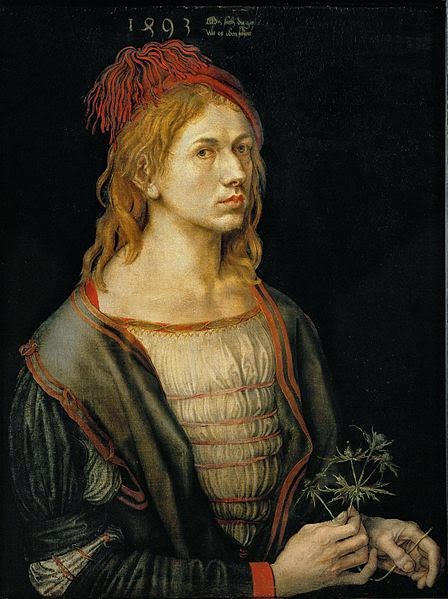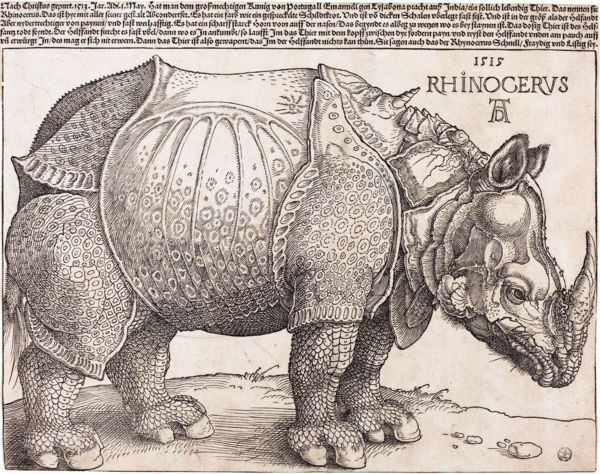
Albrecht Dürer (1471 – 1528)
On May 21, 1471, German painter, engraver, printmaker, mathematician, and theorist Albrecht Dürer was born. He was considered as one of the greatest artists of the Northern Renaissance. Aside from painting, he also excelled in prints. Many of his works focused on Roman Catholicism, mostly altarpieces and other related religious art, but he also did numerous self-portraits. Moreover, his works were also backed up by theories, which join concepts in math, idealistic proportions and perspective.
“I Albrecht Dürer was born in the free imperial city of Nuremberg on the Day of Prudence, which was Friday, the year 1471 was counted.”
— Albrecht Dürer [8]
Early Years of Albrecht Dürer
Albrecht Dürer attended school until the age of 13. In order to becoming a goldsmith, Dürer was apprenticed by his father, and during the year after he began studying art under the painter Michael Wolgemut. His earliest works were accomplished in this period, in which Dürer experimented with his first copperplate engravings and vellum sketches. From Easter 1490 to Whitsun 1494 Dürer went on wanderings to the Upper Rhine; the exact route of this first of three major journeys during his life is unknown. It is possible that he was first in the Netherlands or on the Middle Rhine before staying in Alsace in 1492. During a journey through Italy in the mid 1490’s, Dürer painted several water colored pictures showing landscapes and several pictures in the style of Quattrocento, which he was critically influenced by during his trip.
His Own Workshop
In 1494 he married Agnes Frey (1475-1539), the daughter of a friend of his father’s from an old-established, respected Nuremberg family, who brought only 200 Florin dowries into the marriage. The marriage remained childless. However, even though Albrecht Dürer gained first experiences during these years, his real life as an artist began in 1503 when he went into business by himself and led a workshop with already three employees. In this period, the artist accomplished mostly the self portraits he is now (among the numerous engraved copperplates) so widely known for. He worked very intensively on his works. In this first period of his life as an artist he mainly worked on portraits and some self-portraits:

Albrecht Dürer, Adam and Eve, 1504
Italy Again
The second trip to Italy during the beginning of the 16th century influenced Dürer even more. He finished the ‘Rosenkranzfest‘, one of his best known works significantly influenced by the Venetian art culture and was deeply admired for this work. He was also asked to stay in Italy for a high monthly wage, but preferred to return to his hometown. During the following 10 years, Dürer created mostly copperplate and wooden engravings before intensively concentrating on his studies of proportions and further mathematical issues related to painting, like perspectives. However, he mainly devoted himself to copperplate engraving and to drawing originals for woodcuts. Especially the copper engraving he tested very early; the first dated sheet is from 1497, but it was certainly preceded by several others.

Albrecht Dürer, The Rhinoceros, 1515
The Rhinoceros
In 1515, he created his woodcut of a Rhinoceros which had arrived in Lisbon from a written description and sketch by another artist, without ever seeing the animal himself. An image of the Indian rhinoceros, the image has such force that it remains one of his best-known and was still used in some German school science text-books as late as last century. In the years leading to 1520 he produced a wide range of works, including the woodblocks for the first western printed star charts in 1515 and portraits in tempera on linen in 1516. His only experiments with etching came in this period, producing five 1515–1516 and a sixth 1518; a technique he may have abandoned as unsuited to his aesthetic of methodical, classical form

Albrecht Dürer, The four horsemen of the Apocalypse (1497)
Raising Fame
Dürer’s reputation across Europe grew and during a journey though the Netherlands, he was celebrated and admired by fellow artists and governments, and received numerous presents and awards during his travel. After returning to Nuremberg, Albrecht Dürer led the decoration of the city’s hall. Also he donated two impressive panels to the city of Nuremberg showing the apostles Paulus, Peter, Marcus, and Johannes. These belong to Dürer’s most influential works.
The Art of Woodcut
Dürer’s works as an artist helped to establish a whole new art genre of wooden engravings, like the Rhinoceros from 1515 and he improved the techniques of copperplate engravings critically. He authored several works on the problem of perspective in paintings and was one of the few artists during the Renaissance to be mathematically well educated. Albrecht Dürer read and understood geometrical problems very well, publishing a few works himself, in which he emphasized the meaning of accurate measurement and created new ways of construction geometrical shapes which put him often in contrast to contemporary artists.
Later Years
Despite complaining of his lack of a formal classical education, Dürer was greatly interested in intellectual matters and learned much from his boyhood friend Willibald Pirckheimer, whom he no doubt consulted on the content of many of his images. He also derived great satisfaction from his friendships and correspondence with Erasmus and other scholars. Dürer succeeded in producing two books during his lifetime. “The Four Books on Measurement” were published at Nuremberg in 1525 and was the first book for adults on mathematics in German,[9] as well as being cited later by Galileo and Kepler. The other, a work on city fortifications, was published in 1527. “The Four Books on Human Proportion” were published posthumously, shortly after his death in 1528.
Dürer died in Nuremberg at the age of 56, leaving an estate valued at 6,874 florins – a considerable sum.
Dürer’s Journeys, Travels of a Renaissance Artist, [10]
References and Further Reading:
- [1] Dürer’s hemispheres of 1515 — the first European printed star charts
- [2] Albrecht Dürer at the Met Museum Website
- [3] Albrecht Dürer at Wikidata
- [4] Johannes Vermeer – Master of Perspective and Lighting , SciHi Blog
- [5] Michelangelo Merisi da Caravaggio – Archetype of the Wicked Genius, SciHi Blog
- [6] Not Simply a Piece of Marble – Michelangelo’s David, SciHi Blog
- [7] The Mona Lisa is Missing….!, SciHi Blog
- [8] Norica, das sind Nürnbergische Novellen aus alter Zeit (1.Bd. S. 111), August Hagen, Verlag: Josef Max und Comp., Breslau 1829 in der Österreichischen Nationalbibliothek
- [9] A maths book from a painter, May 21, 2011, at The Renaissance Mathematicus
- [10] Dürer’s Journeys, Travels of a Renaissance Artist, London Art Week @ youtube
- [11] Heaton, Mrs. Charles (1881). The Life of Albrecht Dürer of Nürnberg: With a Translation of His Letters and Journal and an Account of His Works. London: Seeley, Jackson and Halliday.
- [12] Panofsky, Erwin. The Life and Art of Albrecht Dürer. NJ: Princeton, 1945
- [13] Albrecht Dürer: Vier Bücher von menschlicher Proportion (Nuremberg, 1528). Selected pages scanned from the original work. Historical Anatomies on the Web. US National Library of Medicine.
- [14] Timeline for Albrecht Dürer, via Wikidata





